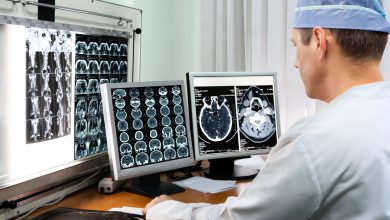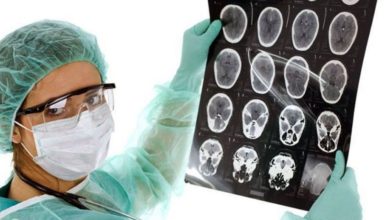Pituitary prolactinoma: symptoms in women
The content of the article
Scientists have conducted many studies aimed at identifying the causes of prolactinoma in women. However, the reasons for the manifestation of this pathology have not been determined.
The formation of this disease can also be caused by:
- Traumatic brain injuries;
- Infection that causes meningitis;
- Renal failure, which has become chronic;
- Pathological processes occurring in the cerebral cortex.
With pituitary prolactinoma, symptoms in women are characterized by headache, high blood pressure, irritability, double vision, narrowing of visual fields and depressive mood. In women, pituitary prolactinoma can appear as a result of autonomous rapid cell division.
As a result, the menstrual cycle is disrupted, which subsequently leads to the impossibility of ovulation. Women secrete colostrum with varying intensity. This can lead to breast problems and the development of mastopathy. An increased amount of prolactin can trigger osteoporosis. In addition, unwanted vegetation forms on the body, greasiness and body weight increase. Depending on the degree of tumor development, appropriate treatment is prescribed. Conservative or surgical methods can be used. However, complete recovery is possible only in a quarter of cases. If prolactinoma is detected during pregnancy, the development of this pathology should be diagnosed. A sharp increase in tumor size can cause severe complications. If progression of the disease is detected, the pregnancy is urgently terminated.
During a normal pregnancy, as the due date approaches, estrogen in the blood increases significantly. When a woman puts her baby to the breast, prolactin levels increase significantly as a response to nipple stimulation. Receptors for prolactin are found in the uterus, liver, placenta, immune cells, intestines and other organs. The task of this hormone is to prepare the mammary glands for subsequent lactation. As a result of its action, milk is synthesized. The hormone also takes an active part in the ovulation process.
The amount of this hormone varies for each woman. Its increase is possible with physical activity and sexual intercourse.
Symptoms
Experts say that a quarter of the population has undiagnosed pituitary tumors . They do not cause symptoms, so they become an incidental finding. It is usually diagnosed between 30 and 40 years of age. Ovarian tumors in women synthesize large quantities of estrogen. This can lead to an increase in prolactin. In this case, it is necessary to examine the pelvic area with an ultrasound.
Prolactin levels in women can decrease significantly as a result of the following factors:
- Taking medications;
- Sheehan syndrome (pituitary infarction);
- Pituitary infarction after childbirth.
During pregnancy, the pituitary gland increases significantly.
However, its blood supply is not normalized. This can lead to a heart attack of an important organ. Death of pituitary cells or hormone deficiency may occur. Therefore, tests show a reduced level of prolactin in the blood. As a result, the woman cannot breastfeed her baby. Medicines and substances can also lead to a decrease in secretion. Among them are nicotine, pyridoxine, and dopamine.
The level of this hormone is extremely sensitive to external influences. This could be stressful situations, food or physical activity. This suggests that the test needs to be done three times to rule out physiological hyperprolactinemia. It is better to donate blood in the morning on an empty stomach. Before the analysis, you should refrain from sexual intercourse, visiting saunas and physical activity. Before the procedure itself, you should relax and calm down as much as possible. If the analysis carried out three times shows that the prolactin level does not correspond to normal values, the specialist will conduct a series of additional tests.
Diagnostics
The doctor will take a history of taking medications, evaluate the function of the thyroid gland, and analyze the MRI of the pituitary gland and hypothalamus. A pelvic ultrasound is also performed, the functioning of the kidneys and liver is assessed, and the hormonal profile is established. If any changes are detected in it, then further examination is carried out. If there are no symptoms, and deviations are recorded only in numbers, then there is no need for treatment.
Prolactinomas secrete prolactin, which stimulates lactation in women after childbirth. A certain amount of prolactin is also produced in males. Pituitary prolactinoma in men affects sexual function and reproduction. It allows the body to produce testosterone and promotes sperm activity. Excessive amounts of prolactin lead to erectile dysfunction, loss of libido and gynecomastia. Prolactinoma affects the decrease in testosterone and disrupts the processes of spermatogenesis. A sharp enlargement of the mammary glands and the development of galactorrhea are possible. In addition, the disease can be expressed in testicular atrophy, osteoporosis and muscle weakness.
Prolactin in pituitary tumors is produced in large quantities, and therefore has a negative effect on physiology. A pituitary tumor is a benign tumor. Prolactinoma is the most common type of tumor. Numerous studies show that a quarter of the population has minor formations in the form of a pituitary tumor. Prolactinoma leads to the formation of the hormone prolactin in excessive amounts. Many people know that prolactin in pituitary adenoma contributes to the normal process of breastfeeding and milk production.
Treatment
Pituitary prolactinoma usually requires medication treatment. Therapeutic methods are aimed at reducing the amount of the hormone in the blood and neutralizing the negative impact.
Pituitary prolactin is an active tumor of the anterior lobe of the organ. Treatment is carried out by an endocrinologist who performs laboratory diagnostics. The specialist uses medications such as Levodopa, Cabergoline, Bromocriptine. Many patients are prescribed Bromocriptine, the results of which can be seen within a couple of weeks. For treatment purposes, drugs that belong to the category of dopamine agonists are used. They restore normal prolactin levels in case of pituitary adenoma and the menstrual cycle. There is a significant decrease in the size of prolactinoma and further development of the disease. If any side effects from the drugs used appear, domperidone is prescribed. The endocrinologist prescribes the drug and the appropriate dosage. To achieve the most effective treatment, it is necessary to periodically check prolactin levels.
There are several indications for the operation:
- Lack of significant effect from drug treatment;
- Tumor enlargement;
- Individual intolerance to the drug;
- Development of pituitary adenoma prolactinoma during pregnancy;
- Damage to the optic nerves and visual impairment;
- Necrosis.
Contraindications for surgery:
- The patient's critical condition;
- Inflammation in the sinuses;
- Respiratory, renal and cardiovascular failure.
Most surgical operations are performed using a transsphenoidal approach. The method involves removing the tumor through the sinuses. During the operation, an endoscopic or conventional surgical instrument is used. Under the influence of the endoscope, prolactinoma is destroyed. Using ultrasound or cryodestruction, the tumor can be eliminated. The craniotomy method is extremely rarely used to remove prolactinoma. If the tumor is very large, the surgeon may not be able to remove it completely. The doctor can only reduce its pressure on areas of the brain. If the prolactin level has decreased significantly, then the operation was successful.
Radiation therapy
Patients who have contraindications are prescribed radiation therapy . However, it has a number of disadvantages, since pituitary insufficiency may develop. The specialist can also choose the method of remote irradiation. It involves the introduction of radioactive gold into the prolactinoma. A special diet , which eliminates excess weight that has formed due to hormonal imbalance. A special diet is developed for the patient, which must contain the necessary microelements. The prescribed regimen should be followed even after complete recovery. The patient is also required to undergo an MRI of the brain annually. Traditional methods of treatment are not welcomed by doctors, since all recipes for infusions inhibit the function of the adrenal glands and other organs. As a result, this negatively affects the overall health of the patient.
In medical practice, a special classification is used based on the size and location of prolactin. Therefore, adenomas are divided into intrasellar, extrasellar and microprolactinomas. The latter are more typical for women. Macroprolactinomas appear in men.
Microprolactinoma of the pituitary gland
Microprolactinoma of the pituitary gland is based on clinical manifestations and anemnesis data. As a result of the compression effect and excessive production of prolactin, this tumor formation appears. The disease often causes visual impairment. The patient's field of vision is significantly narrowed and objects appear double. If prolactinoma is large, it can cause compression of brain tissue. In addition, depression and increased irritability appear. Treatment of this disease occurs dynamically under the supervision of a specialist.
Clinical manifestations depend on the size of adenomas. Depending on the type of tumor, the doctor will also select the appropriate treatment. Since prolactinomas have a tendency to recur, complete recovery occurs in only 25% of treated patients. The most unfavorable prognosis is for those patients who have macroprolactinomas and adenomas, which tend to become malignant.
It should be borne in mind that the amount of hormone does not always reflect clinical manifestations. Because women who have hyperprolactinemia can have a regular menstrual cycle and normal ability to conceive and bear fruit. In this case, a slight excess of the norm can result in unpleasant symptoms. If hyperprolactinemia is detected, the specialist will prescribe an additional test for macroprolactin. If it is less than 40%, then the hormone is outside normal limits and therefore requires examination.
Please rate the article:





